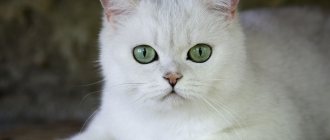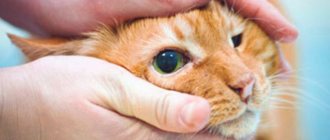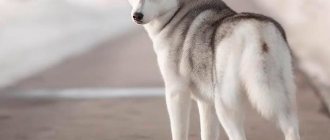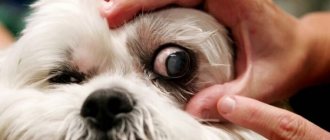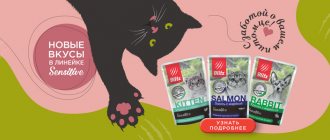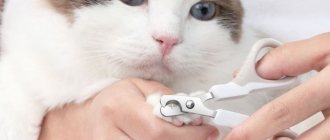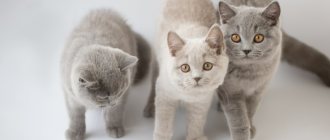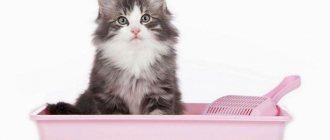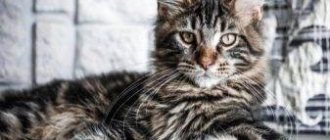Home » Useful Information
Each cat's eye color is unique in its own way. It can depend on breed, genetics and age: everyone knows that all little kittens have blue eyes. But why does this happen and how does eye color change?
- 2 When kittens change eye color
- 3 Eye color standards
- 4 What is heterochromia
Development of kittens (+ table)
Development of kittens (+ table)
Kittens are born small (weight 60-115 g, average body length 12 cm) and completely helpless, blind and deaf; all they can do is find their mother’s nipples, sleep and suck.
They cannot even get rid of excrement products on their own; to do this, the cat licks the appropriate places for them and eats their feces. However, they grow and develop quickly, and watching this process is a fascinating activity! Already a few days after birth, kittens begin to “knead” their mother’s belly with their paws, stimulating the secretion of milk (I wonder who taught them this?) They try to crawl, helping themselves with their front paws. At the age of seven days, a kitten can already crawl several tens of centimeters. At approximately 10-14 days of age, kittens' eyes begin to open.
.
At this age, the eye color of all kittens is blue; it will change to the final adult color (“rebloom”) later, at the age of 3 months. At the same time, the ear canal opens and the kittens begin to hear. In the third week
of life, kittens begin to erupt milk teeth (later they will be replaced by permanent ones). Their vision and hearing improve and they begin to explore the world around them. By the end of the first month of life, they can sit, move quite confidently and learn to play with each other. At one month of age, kittens become interested in trying foods other than their mother's milk.
Kittens older than 4 weeks become even more active and strive for independence. If before this they mainly explored their “nest,” now they are trying to get out of it. The cat spends a lot of energy maintaining order in the family and putting the children in their place. But the activity of kittens is growing by leaps and bounds, although at this age they still do not stray far from their mother. At this time, you need to place a tray next to the nest so that, following the example of their mother, the kittens become accustomed to cleanliness and neatness. Kittens that have been taught to do their business in the litter box by their mother cat will not have any problems with the toilet in the future.
From a month to one and a half months, kittens are very active, learn to lick themselves, play with each other and with their mother, and begin to eat solid food. There is an idea that at this age they can already be taken away from their mother and transferred to new owners. However, this idea is fundamentally incorrect. It is at the age of 1-3 months that kittens watch their mother and learn everything from her. Up to two months, the cat continues to feed the kittens with her milk, which provides them with good immunity to diseases. Therefore, it is not recommended to give away kittens before 2.5-3 months.
.
Complementary feeding of kittens is carried out as follows
. At the age of three weeks, kittens can be offered to drink milk from a saucer (about one teaspoon). Then you can offer some kitten food (see feeding kittens here). After a couple of days, a little baby food should be added to dairy foods, and after another week, it is recommended to replace one daily feeding with a small amount of canned meat. One month old kittens are fed approximately 4 times a day, in addition to their mother's milk. Feed portions are gradually increased. At one and a half months of age, a kitten should eat approximately 3-4 teaspoons of food per feeding.
2–3 weeks: hear, see, begin to walk
In the second week, kittens are actively developing, their hearing continues to develop, but they are not yet able to navigate by sounds. By the end of the second week, babies' eyes open, but vision does not immediately become clear. At the same time, the kitten makes its first attempts to rise on its paws; it cannot yet walk confidently.
Babies see their brothers, sisters and mother for the first time, they learn to communicate, and begin to fight for mother's milk. When they go to bed, they sit closer to each other and their mother. During this period, animals become accustomed to humans. In order for a cat to grow up tame and affectionate, you need to take them in your arms every day. At first, communication with a person lasts only a couple of minutes, but gradually the duration of contact increases.
At this stage of development, the cat controls the behavior of her cubs and teaches them the basics of hunting through play. Kittens get to know the world around them under the supervision of a cat and learn behavioral skills from her.
At three weeks, babies try to stand and move confidently, like adult cats. They estimate the distance correctly. However, weak muscles do not allow them to run quickly; kittens often fall and stumble. By the end of the period, kittens weigh about 300–400 g, they become very active, spend a lot of time playing with their brothers, love to play with toys, and can scratch behind the ear with their hind paw. They are cutting their first teeth.
You can do toilet training. To do this, you need to place the tray in a secluded but accessible place for children. If the kitten sits down to make a puddle, it must be quickly moved to the litter box.
Why do kittens' eyes change color?
Eye color in cats depends on the amount of coloring pigment. Therefore, the reason for the change in eye color is the accumulation of melanin in the eyeball during the development of the visual organs. However, blue color is a recessive trait, which is why eyes of this shade are very rare.
At the moment of embryo formation, there are approximately 3 dozen pigment centers in the body of the future kitten. Migrating throughout the animal’s body during its development, the bulk of them settle in the fur. At the same time, the eyes account for only a small proportion of pigments, which continue to accumulate after the kitten is born. In the process of their accumulation, a change in the color of the kitten’s eyes occurs.
Eye diseases
Changes in eye color are a pathological symptom and occur as a result of the following ailments:
- cataract;
- glaucoma;
- uveitis
Cataract
Characterized by clouding of the lens. Pathology develops as a complication of infectious diseases or occurs in older individuals during age-related changes. The eye takes on a dull gray or bluish tint. The animal's vision deteriorates.
Cataract
Glaucoma
The reason is increased intraocular pressure. The pupil is constantly dilated. Local opacification is observed. Small blood vessels burst, causing the white of the eye to take on a reddish tint. In addition to external manifestations, the cat’s health deteriorates sharply.
Glaucoma
Uveitis
The pupil becomes matte. The conjunctiva turns red. The eye sphere increases. Both eyes are affected and the animal goes blind.
Uveitis
Changes in the pigmentation of the organs of vision can be a normal physiological process, a developmental abnormality, or a consequence of a disease. An alarming symptom is clouding of the pupil or cornea. The pet needs veterinary care.
We invite you to join our Zen channel and group on VKontakte or Odnoklassniki, where new articles for pet owners are published.
Similar articles:
- My cat has a nosebleed - what should I do?
- Inflammation of the lower lip in a cat
- Clear nasal discharge in cats
Physiological features affecting the color of the iris
The color of the animal depends on the accumulation of melanin pigment. There is more of it in the fur, and less in the eye area. The absence of a coloring component is indicated by the blueness of the organs of vision. The phenomenon is typical for albinos. However, the transformation of the visual organs is also associated with age-related changes.
Up to two weeks, the color of the cub's eyes is masked by a grayish film. In a growing kitten, pigment accumulates, so the color of the iris changes. The following eye colors are typical for cats:
- bluish;
- green;
- yellow;
- orange (copper).
The main tone of the kitten's eye color is formed by 17 weeks. It is at this age that a breeder should purchase a breeding animal.
Breed differences
The color of the iris is a sign of a purebred cat. For some breeds, eye color does not matter. Others - with atypical coloring - are excluded from breeding. Blue eyes are characteristic of albinos of different breeds. A distinctive feature of the British is the orange iris. For black solids, any color except green is acceptable. The standard for Siamese and Thai cats is blue.
Pathological causes
There are hereditary disorders and diseases in which the organs of vision change color:
- genetic abnormalities;
- ophthalmological diseases.
Heterochromia is considered a congenital defect that does not affect health. Most often, unequal coloring of the right and left eyes is observed. Sometimes segments of one of the irises are colored differently. The anomaly is a consequence of uneven distribution of pigment. A high percentage of heterochromia is observed in Angora cats. The phenomenon is considered a deviation from the norm, and such individuals are excluded from breeding.
Heterochromia
When does eye color change occur?
Each cat breed changes eye color at certain times. Most often it occurs between 2 weeks and 12 months after the eyes begin to open. A kitten's eye color changes gradually. Two weeks after birth, the eyes are covered with a cloudy film. Because of this, they appear to have a gray tint. And only then the shade becomes more pronounced. From this moment you can approximately determine what eye color will be. However, you cannot be sure of this, since the range of shades is very large - from a gray-blue tint to brown. Therefore, those who get a purebred kitten and want it to have a particular eye color most often adopt it at the age of 4 months.
It is worth noting that if the kitten initially had yellow eyes, then this color becomes brighter - amber, copper or golden. That is, brown eyes can never acquire a blue tint.
Content Features
Despite their natural health, Britons require proper care.
To extend your cat's life, choose the right food. Ideally, you should visit a veterinarian who will create a healthy diet. Take your pet to the veterinarian regularly: the cat will not complain if it gets sick.
Wet food for cats from 12 months View product
Dry food for cats from 12 months View product
Dry food for kittens from 4 to 12 months View product
It's easy to care for the cat's fur - buy a massage slicker brush and brush your cat 2 times a week. The Briton needs to be washed a couple of times a year or as needed.
Pay attention to the animal's eyes - they are looked after every day. A cotton pad is used to remove natural discharge from the eyes, and the cotton wool is led from the outer corner to the nose. The ears are examined a couple of times a month and cleaned with cotton wool treated with a hygienic solution.
You need to examine your pet's teeth every day to prevent tartar from developing. Breeders recommend teaching your British cat to brush his teeth from an early age.
Such pets are sensitive to drafts and catch colds easily: protect your cat from drafts.
Rare colors
Amber is a new and not yet approved species. Externally similar to golden, but more subdued. The peculiarity is the presence of single black hairs located nearby.
Doubts about color are caused by the fact that dark stripes or dots are visible against a warm background, and cats, not at the genetic level, can be either black or red. For now, Amber is recognized in one of the felinological organizations for the Kuril Bobtail breed.
Kittens with the rare fawn color are a gift for many breeders. It is a variation of lilac, but a very light shade. The color of the nose is beige and pink, as are the pads on the paws. Eyes amber or copper.
This is a monochromatic color, the pigment in the hairs is evenly distributed. The quality of British wool should not suffer from bleaching, despite its apparent softness.
Cinnamon or cinnamon is a derivative of the chocolate color. The color is solid and uniform, without blemishes or marks. The shade is delicate, slightly muted. The color of the nose of the cinnamon is brownish-pink.
There are two types of shade: yellow and red. It is layered on top of the base brown. The paw pads are colored similarly to the nose.
Primary colors
Today, the number of Scottish Fold colors includes about a hundred variations. Moreover, the color of a Scottish cat’s coat is not immediately established. At six months the kitten will have its first molt, after which the baby fur will change to an adult one. Later, the color may change slightly and is finally established only by two years.
Scots have 2 main genes that are responsible for the red and black coat colors. In addition, there is a third gene called diluent, which determines the saturation of the pigment. One of the two main genes takes over, the combination occurs in a different order, resulting in different colors in Scottish Folds.
It is because of this play of genes that the black color turned out to be bluish, the chocolate color turned into lilac, and so on. Even when forming a color, such indicators as the degree of coloring of each hair hair and the presence of spots and patterns are important. Among the Scottish Folds there are also pure white individuals. This means that they lack the gene responsible for color and the suppression of the gene for this color by other genes.
Plain
These colors of cats are characterized by uniform coloring of the coat. If there are inclusions, then this color is classified as non-uniform. Due to the presence of such a small defect, the price of a kitten is reduced. This group includes:
- blue;
- white;
- chocolate;
- lilac;
- black – ebony;
- faun;
- red;
- cinnamon – reminiscent of the color of cinnamon;
- cream or peach.
Two-color or bicolor
The coat color of these feline representatives consists of two parts: one is white, and the second is one of the same colors or striped. Ideally, the pattern should be located symmetrically on the cat's body.
Point
The color in this case resembles the coloring of Siamese cats, that is, the main body color is always light, and the mask, ears, tips of the paws and tail are darker. There are subspecies with lilac, chocolate, cream blue and even tortoiseshell splashes. This color occurs due to a special gene that darkens areas of the body with a lower temperature.
Torties or tortoiseshells
The name of this rare color comes from the English word "turtle". The color is formed by spots of dark, red or cream colors. They come in black or chocolate-red, blue or lilac-cream. At the same time, the colors are distributed evenly, so they should not be confused with calico cats. Normally, this coloring occurs only in females. If a male Scottish Fold tortoiseshell is born, then this is the result of a mutation, and he will not bear offspring.
Smoky
The coloring suggests that the hairs have a uniform color along almost the entire length, and become lighter at the base. The color of the hairs, when they have part of a silver-white color and part of any other shade, is called tipping. The dominant gene for silver color is responsible for it.
Tabby
Everyone's favorite minke whales are also among the Scottish Folds. They are characterized by a “crown” pattern on the head, highlighting at the back of the ears, a border around the eyes and nose, stripes on the neck, paws and tail. Tabbies are divided into different subspecies:
- brindle;
- leopard print;
- marble.
By color pigment, tabbies are classified as follows:
- silver with a black pattern;
- silver-blue with a whitish undercoat;
- blue – there is a blue pattern on a creamy blue background;
- brown with black stripes, spots or stains;
- cream;
- red;
- cameo tabby, suggesting a red pattern on a white background.
They combine two colors at once: white and tortoiseshell.
Chinchilla
In this color, the tipping effect takes the following form: only one-eighth of the hair is colored dark, and the rest is white. Among them the following varieties are distinguished:
- silver;
- gold;
- blue golden is the rarest type of color.
The ticking effect involves dyeing the hairs not in two, but in three colors at once.
Shaded
In them, the pigment colors only the very tip of the hairs, and the rest of the hair is white. There is a light undercoat, a shaded part of the hair fibers in certain areas of the body - at exhibitions, experts evaluate how evenly and correctly it is located. The presence of signs of a tabby pattern is prohibited. They are divided into:
- red;
- silver;
- golden.
Wang
Their color combines a white body with a tail and muzzle of a darker shade, possibly interspersed with several spots with a plain or tabby pattern.
Harlequin
These are white individuals with a dark tail, as well as spots that are not located next to each other, but are distributed throughout the body. Such animals look very colorful, which is why they got such an interesting name.
Popular misconceptions about changing eye color in cats
On many forums where inexperienced breeders begin to advise cat lovers on how to care for them, incorrect information comes across. Popular misconceptions about eye changes in cats include the following facts :
- All kittens, without exception, initially have a blue-gray tint to their eyes.
- There is a relationship between fur color and iris color.
- The color of the iris depends on the kitten's diet.
Each of these theories has no scientific proof. But despite this, breeders are taking measures to breed cats with exactly the eye color that is becoming the standard.
Green-eyed breeds
Long-haired and short-haired Persians with a chinchilla-colored coat are known for their green eyes with a black “rim.” The Tonkinese breed has striking sea green eyes.
Russian Blue cats have emerald green eyes that contrast beautifully with their gray-blue coat. And the Egyptian Mau's irises resemble juicy gooseberries.
Common Misconceptions
On the Internet you can find many myths and misconceptions related to the process of “repainting” cat eyes. Here are just a few of them:
- All newborn kittens must have bright blue eyes. Some believe that deviations from this “norm” threaten serious pathologies. In practice, it happens that kittens’ eyes can be colored in different gradations of gray and blue colors... And all this is the norm. If the iris of a recently born kitten is not blue, this is not a pathology!
- There is a common misconception about the correlation between coat color and eye color. This opinion is partly true. But only for representatives of certain breeds whose coat color was “tied” to the color of the iris during a long and difficult selection process. It’s just that in their case, the eye color can actually be anything, and this is also not considered a deviation.
- Some breeders are truly convinced that eye color depends on... diet. But this “theory” is absolutely not confirmed either by science or by practical observations of breeders. It is known, however, that frequent feeding of fish can cause a cat’s fur to noticeably darken, but even in this case, its eyes will not change color.
We invite you to read: What types of discharge can occur in cats after giving birth and when treatment is required
Characteristic
Representatives of the Scottish Fold breed can be found in some sources under the name Scottish Fold. This cat breed is quite new, so it is not as common in the world as other cat breeds. However, this does not make them less popular among pets in all countries. Like any other breed, Scottish Folds have their own distinctive characteristics:
- a harmoniously built body with correct proportions;
- average paw length with a well-developed muscular system;
- straight long tail;
- the head has a rounded shape due to plump cheeks;
- the muzzle is not flat, but not particularly elongated;
- round eyes, the color of which differs depending on the color;
- small ears pressed to the head.
Since this cat breed is considered relatively young, the signs of a purebred Scottish representative are still debated among experts. However, some common characteristics have already taken root.
- The average weight is from 3 to 6 kg.
- The height of an adult can reach 28-34 cm.
- The World Cat Federation does not have a specific requirement for the color of Scottish Fold cats, but the Association of Cat Fanciers does not recognize some coat colors: chocolate, lilac-blue and colorpoint.
- Life expectancy is about 13-15 years, but if the cat does not have congenital diseases, then it can live up to 20-23 years.
- Scottish Fold cats have a kind, quiet character; by their nature, they are very indifferent to everything that happens around them. Lazy by nature, he will prefer to sleep peacefully in his arms rather than follow the heels of his owner. Such a cat will never remain indifferent to the downcast mood of the owner and will definitely come to him in order to console him.
- As for their mental abilities, what should be noted here is their ability to quickly get used to the tray and scratching post.
It should be noted that Scottish Fold cats are not vindictive, but timid. For this reason, you should not shout or scold your pet too much, as this can affect the animal’s mental state. They really like to watch the actions of their owners, to be just outside observers. They are not clingy. If they need anything, the animals will simply meow quietly, and not yell at the whole house.
Scottish fold blue cats easily take root in a new home, and quite quickly remember what they are forbidden to do and where they should not go. The good news for those who want to teach their pet commands is that the Scots learn the simplest commands quite quickly and easily.
When traveling, representatives of this cat breed behave calmly and quietly. Having prepared a comfortable place for your pet, you can easily take it with you on vacation - it tolerates travel quite easily. The owner is required to have a convenient basket for transporting the animal, a pre-prepared tray for urinating, and bowls for water and food.
What do they say about cats with blue eyes?
Cat eyes have four primary colors – blue, green, yellow and copper. What eye color your pet will have depends on genetic characteristics. If he is predisposed to the presence of a large number of melanocytes, then his eyes will be dark, if there is little of this pigment, they will be light.
There are no blue eyes as such. If a cat has eyes of this shade, then its body does not produce enough pigments. We simply mistake the reflection in their transparent part for the blueness of the eyes. However, scientists have not established a connection between a cat’s health and its life expectancy.
Tabby or spotted cats
Tabby
Cats of this color can be of two types - classic tabby, also called marbled or tabby. Scottish Fold kittens are usually multi-colored and have circular rings on the back of their heads and behind their shoulders, usually a darker color than their base color.
Tabby and marbled cats can have colors such as:
- Blue marble;
- Lilac marble;
- Chocolate spotted;
- Black marbled or spotted;
- Cream or red marble and others.
Marbled cats may have an "M" shape and a striped tail. Silver and marbled cats may have green or yellow-green eyes. It looks very nice.
Keeping Scottish cats
Since these animals are short-haired, they do not require any special grooming. It is necessary to organize periodic combing with a special brush for cat hair and washing as needed. In order for your cat to feel good, it is enough to brush it no more than once a week.
For the health of the animal, it is also necessary to clean its ears, approximately once a month. This will help avoid the occurrence of many diseases and maintain hygiene at the required level. It is also necessary to take care of timely trimming of claws, this must be done so that the animal cannot hurt anyone, including itself.
What is heterochromia
Heterochromia is the presence of different colored eyes in one cat. There are two types of heterochromia:
- complete - both eyes are completely different in color;
- sectoral - part of the eye (from a quarter to three quarters) of a different color.
Heterochromia can be either congenital or acquired. Congenital is formed under the influence of genes, acquired can appear due to injury or after illness. Congenital heterochromia is also associated with the movement of pigment - if one eye falls into an area where less pigment moves, it may be a different color from the genetically determined one.
Heterochromia can appear in any variations: brown and blue, brown and green, green and blue, copper and brown, copper and yellow, etc. But most often it is blue and yellow.
Heterochromia is also called heterochromia
Any cat can have heterochromia, even a purebred one, but for some breeds the standard considers heterochromia to be normal, while for others it is not. Which breeds can be heterochromic according to the standard:
- Kao-mani.
- Turkish Angora.
- Turkish van.
- Minskin.
- Munchkin.
- Ojos azules.
- Canadian Sphynx.
- Don Sphynx.
- Some colors of British and Scottish cats (for example, solid white).
As a rule, you can understand what eye color a kitten will have as early as 4 months. It is at this age that you should take kittens if you want a certain eye color.
Red eyes only occur with albinism
Little kittens are adorable in large part due to their beautiful blue eyes. For some, this color remains for life, for others it changes at a certain age. But the main thing is that the color of a cat’s eyes does not determine its character at all. A cat with any eye color is beautiful, and any cat can become a devoted and affectionate pet for you.
WHEN DO BRITISH KITTENS OPEN THEIR EYES AFTER BIRTH?
After birth, kittens' eyes open at about 7-10 days, less often at 14-15 days.
Interesting! If kittens lie in a dark box, they open their eyes earlier.
At this age, the eyes are watery and very sensitive, so at this age it is better not to expose them to bright lighting, the sun and not to take photographs.
WHEN DO BRITISH KITTENS CHANGE EYE COLOR?
Kittens are always born with blue eyes. This eye color lasts up to 1.5-2 months, then they begin to change color to their main eye color, which matches the color.
VARIETIES OF BRITISH EYE COLOR
The British have four types of eyes:
- Blue eyes - blue, designated by BRI code 61
- Yellow eyes (orange, golden, copper, etc.) - yellow, golden, indicated by BRI code 62
- Different eyes - odd eyed ("with odd eyes"), indicated by BRI code 63
- Green eyes - green, designated by BRI 64 code
Let's talk in more detail about each eye color.
BRITISH CATS WITH BLUE EYES
The beautiful blue eyes of British cats are found only in color point and other white colors.
The cat's body is point-colored, with white and dark markings on the face (mask), ears, and tail.
White British cat with blue eyes (indicated by BRI code w 61). Such cats are sometimes deaf, so the kittens are carefully examined by a veterinarian.
Color point British cat with blue eyes (BRI b 33 61)
British cat, point silver chinchilla with blue eyes (BRI ns 33 61)
British cat white with blue eyes (BRI w 61)
British kittens with blue eyes, point tabby color (BRI ns 21 33 61)
BRITISH CATS WITH YELLOW EYES
It should be noted that most British cats have yellow (golden) eyes. This is according to the breed standard. The eyes of British kittens turn yellow after 2 months.
Colors of British cats with yellow eyes:
- plain (black, blue, chocolate, lilac, cinnamon, fawn, red, cream)
- colors with white (bicolor, van, harlequin)
- tabby – cats with a pattern – spotted, striped, marbled, ticked (except golden color)
- tortoiseshell colors
- white (white colors are found not only with yellow eyes)
British blue (gray) cat with yellow eyes (BRI a 62)
British black cat with yellow eyes (BRI n 62)
British cat with yellow eyes, color cream bicolor (BRI e 03 62)
British lilac kittens with orange eyes (BRI c 62)
White British cat with yellow eyes (BRI w 62)
British cat with yellow eyes, chocolate spotted color (BRI and 24 62)
BRITISH CATS WITH DIFFERENT EYES
Found only in white cats
These cats look very impressive, unusual, and attract attention.
British white cat with different eyes (BRI w 63)
BRITISH CATS WITH GREEN EYES
British cats with green eyes only come in silver and gold colors (chinchilla and tabby).
Moreover, the golden color should always only have green eyes, while the silver ones have both green and yellow eyes.
Golden cats with yellow eyes are rejected. The British golden cat (looks like a red cat) with green eyes looks bright and elegant. Today this is a relatively new color, bred by felinologists.
British golden cat with green eyes (BRI ny 25 64)
Silver chinchilla, British cat with green eyes (BRI ns 11 64)
British cat with green eyes, marbled color (BRI ns 22 64)
EYE CARE FOR A BRITISH KITTEN
Due to the characteristics of the British breed and their short baby-face muzzle, the nasolacrimal duct takes a long time to form, so the kittens develop tear discharge. Eye care includes rubbing your eyes daily.
HOW TO WASH AND WHAT TO WIPE A BRITISH KITTEN'S EYES?
The best way to wipe the British eyes is with a cotton pad moistened with boiled water. You need to use a different cotton pad for each eye. It is not recommended to wash your British kitten's eyes with herbal tea, because... they leave marks on the fur. Sometimes, if there is excessive tearing, you can use “diamond eyes” drops; they wash the eyes well and dry them a little to reduce the discharge.
Closer to the year, the discharge from the British eyes is reduced to a minimum or disappears completely.
In our nursery there are British kittens with eyes: yellow, green, blue, odd-eyed.
Cat breeds and eye colors
As mentioned above, breed is not a 100% factor in whether an animal's eyes are a particular color. However, people are accustomed to certain standards and the norm for them is a specific eye color in individuals of certain breeds :
- British breed - bright orange or amber hue.
- Russian Blues have green eyes.
- White British people have blue eyes.
- Black layer - eyes should not be green.
- Scottish cats are green or copper in color.
By paying attention to the fact that kittens' eyes change, you can determine their age.
Breed differences
The standard for each breed contains a list of acceptable iris shades.
All Thai cats must have blue eyes. The aquamarine hue of their pupils should be bright and deep. Dullness is considered a disqualifying factor, excluding the animal from breeding work. Similar requirements apply to representatives of the Siamese breed.
Burmese beauties should have eyes ranging from a rich golden to lemon shade. Any deviation from the standard is unacceptable. Oriental cats are distinguished by grass-green eyes of varying intensity. For British and Scottish cats, copper, amber or terracotta colored eyes are preferred. And a green iris will ruin the exhibition career of even the most beautiful British woman.
Maine Coons can have corneas of any shade. The main thing is that the color is as pure as possible and does not contain other inclusions. The same requirement is prescribed for representatives of the Bengal breed. The only exceptions are individuals with the lynx point (snow) color, which must be blue-eyed.
Siberian cats are the pride of Russian felinology. Green and yellow shades of the pupils are considered the most acceptable for them. However, the color-point Siberian subspecies Nevskaya Maskaradnaya should have a piercing sky-blue gaze.
Colors of Shorthair Scottish Fold cats (Scottish Fold Colors)
White (WHITE)
: Pure white, shiny. Eyes: deep sapphire blue or gold. A white with different eyes should have one eye sapphire blue and the other golden with equal color saturation. Nose and paw pads: pink. Black (BLACK)
: Black, coal without any rusty mixture.
Painted along the entire length. Nose is black. The pads are black or brown. The eyes are golden. Blue (BLUE)
: blue, preferably light blue, uniform.
Equally darkish is preferable to light with transitions and shades throughout the body. The nose and pads are blue. The eyes are golden. Red (RED)
: deep brilliant red, uniform, without smoke, pattern or ticking (at least see this in person, reds always have smoke, tabi, etc.).
White hairs are not allowed. Nose and pads: brick red. The eyes are golden. Cream (CREAM)
: Light shades are preferable, the color is uniform throughout the body. Nose and paw pads: pink. The eyes are golden.
Tortoiseshell and shaded
The name “shaded” refers to the color of Scottish cats, in which there is a soft transition from white to a multi-colored shade. As a rule, the animal's paws, belly, neck and chest are painted white, and the rest of the body has golden or gray streaks. The shaded red suggests stripes on the sides and base of the tail. The cat's face should remain light. With silver shading, the undercoat and ends of the long coat remain white.
Tortoiseshell color implies the presence of spots of different shades. As a rule, they have a brown tint with red markings. When purchasing a kitten, you should take into account the fact that the more harmoniously the spots are located, the more points the pet will receive at exhibitions. However, today there are no restrictions regarding tortoiseshell spots. That is, the breed standard allows any size and location.
Ticked color
Clear ticking (uniform zonal coloring, alternating dark yellow rings along the entire length of the hair with a dark tip) without traces of a pattern on the body. Bright representatives of the ticked color? Abyssinian and Somali cats.
Chinchilla
With this color, one eighth of the guard hair is colored, the rest of the hair is white. Varieties of color:
- Silver chinchilla. The undercoat of this color is white or light with black shading on the sides, back and tail. The tips of the ears, chin and belly are white.
- Golden chinchilla.
It is distinguished by red shading on the tail, back, head and sides. The animal's muzzle and paws can be obscured by tipping. - Blue golden chinchilla.
The rarest color among chinchillas. It is characterized by an undercoat the color of baked milk and blue shimmering tipping. The eye color of this color is emerald.
How do kittens' eyes change?
The final eye color in cats is established by the age of 2 years. The process of changing the color of the iris is called reblooming. Most often it begins in the 4th week of a kitten’s life. In this case, the usual blue tint of the eyes is diluted with splashes of a different color. Gradually, these inclusions grow and the animal’s eyes acquire a constant shade.
Sometimes in white cats you can observe a difference in eye color. For example, one of them is green and the other is blue. This phenomenon is called heterochromia. Most often it is found among Turkish Vans, in rare cases among representatives of the British, Scottish or Persian species. Cats' eyes can not only change color, but also fade with age. At the same time, once bright shades turn into dull ones.
So, if you have a preference for cats with a certain eye color, adopt a kitten at 4 months of age. At this time, it is already possible to determine what color of the pet’s iris will be. Later it may acquire greater depth and richness, but its basic tonality will remain unchanged. It is worth noting that eye color is not a feature of a particular breed. This is a purely genetic criterion, where blue color is a recessive trait.
Choosing a name
The animal's name should reflect its nature, character traits or appearance. These are usually the main criteria. It’s good if the name contains hissing sounds: this will help the animal quickly get used to its nickname. Her choice depends solely on the owner’s imagination. The name should be short and easy to pronounce: this will be more convenient for both the owners and the animal. There are a number of suitable nicknames for boys.
- You can name a cat by a traditional cat name: Fluff, Plyukha, Iris, Bow, Busik.
- Sometimes an animal is called by a human name. You can choose a noble name to match your pet: Leopold, Sylvester, Archibald.
- A purebred cat would be nicknamed Winston, Zorro, Raisin, Marquis.
There is also a choice for girls:
- based on its external features, you can give it the touching nickname Nochka, Lapka;
- the cat will remember cute words with hissing sounds: Ixi, Christy;
- The beautiful name Agrafena (Pear), Taisiya (Tasya) would be suitable.
You will learn more information about the Scottish Fold cat breed from the following video.
How to find out the age of a kitten
Every owner should know how old his pet is. It's easy to see the difference in what a 1 month or 1 week kitten looks like in appearance. It develops at a rapid pace, at each specific stage there are characteristic signs that indicate an approximate date (only a veterinarian can say for sure). There are certain ways that will help you find out how old your pet “predator” is. The time of birth can be determined using the following criteria:
Nutrition and care
Despite the fact that adults of this cat breed are calm and lazy, at a young age they need to be carefully monitored, since Scottish Fold kittens are energetic, restless and playful.
For this reason, you need to hide in advance various kinds of wires and fragile objects that the kitten may like. When choosing bowls for feeding, preference should be given to heavy containers so that the baby cannot knock them over. It is worth taking care of a place to relieve its natural needs, so that from the first days the pet learns to go to the toilet only there.
You need to find a place in the house for your pet to rest and equip it with a house or bedding in advance. You also need to buy a scratching post or make one yourself. To do this, wrap a thick rope tightly around the table leg.
Like any child, Scottish Fold kittens are very playful, so you need to buy them several different toys, otherwise these toys may become the owners' clothes or shoes.
Caring for this breed of cat is about the same as caring for any other cat. At least once every 1-2 weeks you need to comb his fur, for which you need to buy a special brush designed specifically for this. When bathing (about once every 6 months), under no circumstances should water get into your ears.
Once every two weeks, you need to clean your cat's ears using a rolled-up cotton pad. Using special scissors for trimming your pet's nails, you should shorten their length at least once a month. Deworming should be carried out once every three months, and fleas should be driven away in early spring.
It is worth keeping an eye on the animal's eyes: if they begin to turn sour, you need to wipe them with a cotton pad dipped in brewed strong black tea. If the eye condition does not improve within a week, you should take your pet to the veterinarian.
Scottish Fold blue cats are prone to gaining excess weight. To keep your pet healthy, you need to take its diet seriously. Representatives of this breed can be fed with premium-class dry food from a trusted manufacturer. Pet stores sell food specialized for a specific breed of cat. They contain all the microelements necessary for the full development and functioning of a pet.
Also suitable are boiled chicken offal, boiled sea fish, eggs, kefir, fermented baked milk, vitamin complexes (after consultation with a veterinarian).
For those who have decided to purchase a Scottish Fold blue cat kitten, it is necessary to contact only trusted breeders who will be able to provide all the documents of the kitten’s parents, including vaccinations.
Additional characteristics about the Scottish Fold blue cat can be found in the video below.
How kittens grow
The surest way to determine the age of a kitten is by observing it. There are certain periods of development of an organism that indicate the date of its birth. The older the pet, the more difficult it is to know exactly how old he is. The easiest way to do this is before 1 month, when the main stages of the formation of all animal body systems occur:
- the umbilical cord disappears;
- the baby begins to stand on his feet;
- body weight increases;
- eyes open, their color changes;
- teeth appear and grow.

